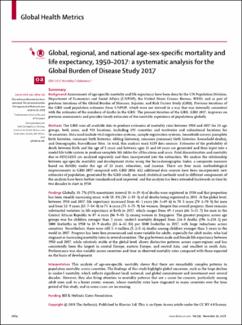Global, regional, and national age-sex-specific mortality and life expectancy, 1950–2017: a systematic analysis for the Global Burden of Disease Study 2017
Fecha
2018-11-10Autor
Dicker, Daniel
Nguyen, Grant
Abate, Degu
Abate, Kalkidan Hassen
Abay, Solomon M
Abbafati, Cristiana
Abbasi, Nooshin
Abbastabar, Hedayat
Abd-Allah, Foad
Abdela, Jemal
Abdelalim, Ahmed
Abdel-Rahman, Omar
Abdi, Alireza
Abdollahpour, Ibrahim
Suliankatchi Abdulkader, Rizwan
Abdurahman, Ahmed Abdulahi
Abebe, Haftom Temesgen
Abebe, Molla
Abebe, Zegeye
Abebo, Teshome Abuka
Aboyans, Victor
Niguse Abraha, Haftom
Roba Abrham, Aklilu
Abu-Raddad, Laith Jamal
Abu-Rmeileh, Niveen ME
Kokou Accrombessi, Manfred Mario
Acharya, Pawan
Adebayo, Oladimeji M
Akinkunmi Adedeji, Isaac
Adedoyin, Rufus Adesoji
Adekanmbi, Victor
Adetokunboh, Olatunji O
Meressa Adhena, Beyene
Adhikari, Tara Ballav
Adib, Mina G
Kouablan Adou, Arsène
Adsuar, Jose C
Afarideh, Mohsen
Afshin, Ashkan
Agarwal, Gina
Aggarwal, Rakesh
Aghayan, Sargis Aghasi
Agrawal, Sutapa
Agrawal, Anurag
Ahmadi, Mehdi
Ahmadi, Alireza
Ahmadieh, Hamid
Cheikh brahim Ahmed, Mohamed Lemine
Ahmed, Sayem
Ahmed, Muktar Beshir
Aichour, Amani Nidhal
Aichour, Ibtihel
Eddine Aichour, Miloud Taki
Akanda, Ali S
Akbari, Mohammad Esmaeil
Akibu, Mohammed
Akinyemi, Rufus Olusola
Akinyemiju, Tomi
Akseer, Nadia
Alahdab, Fares
Al-Aly, Ziyad
Alam, Khurshid
Alebel, Animut
Aleman, Alicia V
Addis Alene, Kefyalew
Al-Eyadhy, Ayman
Ali, Raghib
Alijanzadeh, Mehran
Alizadeh-Navaei, Reza
Aljunid, Syed Mohamed
Alkerwi, Ala'a
Alla, Francois
Allebeck, Peter
Allen, Christine A
Alonso, Jordi
Al-Raddadi, Rajaa M
Alsharif, Ubai
Altirkawi, Khalid
Alvis-Guzman, Nelson
Amare, Azmeraw T
Amini, Erfan
Ammar, Walid
Amoako, Yaw Ampem
Anber, Nahla Hamed
Andrei, Catalina Liliana
Androudi, Sofia
Animut, Megbaru Debalkie
Anjomshoa, Mina
Zelalem Anlay, Degefaye
Ansari, Hossein
Ansariadi, Ansariadi
Ansha, Mustafa Geleto
T Antonio, Carl Abelardo
Yaw Appiah, Seth Christopher
Aremu, Olatunde
Abera Areri, Habtamu
Ärnlöv, Johan
Arora, Megha
Artaman, Al
Aryal, Krishna K
Asadi-Lari, Mohsen
Asayesh, Hamid
Tsegay Asfaw, Ephrem
Weldegebreal Asgedom, Solomon
Assadi, Reza
Ataro, Zerihun
Mehari Atey, Tesfay Mehari
Shamsadin Athari, Seyyed
Atique, Suleman
Atre, Sachin R
Atteraya, Madhu Sudhan
Attia, Engi F
Ausloos, Marcel
Avila-Burgos, Leticia
Avokpaho, Euripide FGA
Awasthi, Ashish
Awuah, Baffour
Ayala Quintanilla, Beatriz Paulina
Ayele, Henok Tadesse
Ayele, Yohanes
Ayer, Rakesh
Ayuk, Tambe B
Azzopardi, Peter S
Azzopardi-Muscat, Natasha
Badali, Hamid
Badawi, Alaa
Balakrishnan, Kalpana
Bali, Ayele Geleto
Banach, Maciej
Banstola, Amrit
Barac, Aleksandra
Barboza, Miguel A
Barquera, Simon
Barrero, Lope H
Basaleem, Huda
Bassat, Quique
Basu, Arindam
Basu, Sanjay
Baune, Bernhard T
Bazargan-Hejazi, Shahrzad
Bedi, Neeraj
Beghi, Ettore
Behzadifar, Masoud
Behzadifar, Meysam
Bejot, Yannick
Begashaw Bekele, Bayu
Belachew, Abate Bekele
Gebreyesus Belay, Aregawi
Belay, Ezra
Belay, Saba Abraham
Metadatos
Mostrar el registro completo del ítemResumen
Background Assessments of age-specific mortality and life expectancy have been done by the UN Population Division, Department of Economics and Social Affairs (UNPOP), the United States Census Bureau, WHO, and as part of previous iterations of the Global Burden of Diseases, Injuries, and Risk Factors Study (GBD). Previous iterations of the GBD used population estimates from UNPOP, which were not derived in a way that was internally consistent with the estimates of the numbers of deaths in the GBD. The present iteration of the GBD, GBD 2017, improves on previous assessments and provides timely estimates of the mortality experience of populations globally.
Methods The GBD uses all available data to produce estimates of mortality rates between 1950 and 2017 for 23 age groups, both sexes, and 918 locations, including 195 countries and territories and subnational locations for 16 countries. Data used include vital registration systems, sample registration systems, household surveys (complete birth histories, summary birth histories, sibling histories), censuses (summary birth histories, household deaths), and Demographic Surveillance Sites. In total, this analysis used 8259 data sources. Estimates of the probability of death between birth and the age of 5 years and between ages 15 and 60 years are generated and then input into a model life table system to produce complete life tables for all locations and years. Fatal discontinuities and mortality due to HIV/AIDS are analysed separately and then incorporated into the estimation. We analyse the relationship between age-specific mortality and development status using the Socio-demographic Index, a composite measure based on fertility under the age of 25 years, education, and income. There are four main methodological improvements in GBD 2017 compared with GBD 2016: 622 additional data sources have been incorporated; new estimates of population, generated by the GBD study, are used; statistical methods used in different components of the analysis have been further standardised and improved; and the analysis has been extended backwards in time by two decades to start in 1950.

